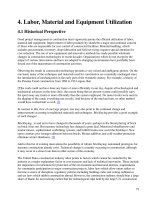Construction management for industrial projects
Bạn đang xem bản rút gọn của tài liệu. Xem và tải ngay bản đầy đủ của tài liệu tại đây (16.25 MB, 414 trang )
This page intentionally left blank
Construction Management
for Industrial Projects
Scrivener Publishing
3 Winter Street, Suite 3
Salem, MA 01970
Scrivener Publishing Collections Editors
James E. R. Couper
Richard Erdlac
Pradip Khaladkar
Norman Lieberman
W. Kent Muhlbauer
S. A. Sherif
Ken Dragoon
Rafiq Islam
Vitthal Kulkarni
Peter Martin
Andrew Y. C. Nee
James G. Speight
Publishers at Scrivener
Martin Scrivener ()
Phillip Carmical ()
Construction
Management for
Industrial Projects
A Modular Guide for Project Managers
Mohamed A. El-Reedy
Consulting Engineer
φ
Scrivener
WILEY
Copyright © 2011 by Scrivener Publishing LLC. All rights reserved.
Co-published by John Wiley & Sons, Inc. Hoboken, New Jersey, and Scrivener Publishing
LLC, Salem, Massachusetts.
Published simultaneously in Canada.
No part of this publication may be reproduced, stored in a retrieval system, or transmitted in
any form or by any means, electronic, mechanical, photocopying, recording, scanning, or otherwise, except as permitted under Section 107 or 108 of the 1976 United States Copyright Act,
without either the prior written permission of the Publisher, or authorization through payment
of the appropriate per-copy fee to the Copyright Clearance Center, Inc., 222 Rosewood Drive,
Danvers, MA 01923, (978) 750-8400, fax (978) 750-4470, or on the web at www.copyright.com.
Requests to the Publisher for permission should be addressed to the Permissions Department,
John Wiley & Sons, Inc., Ill River Street, Hoboken, NJ 07030, (201) 748-6011, fax (201) 748-6008,
or online at />Limit of Liability/Disclaimer of Warranty: While the publisher and author have used their
best efforts in preparing this book, they make no representations or warranties with respect
to the accuracy or completeness of the contents of this book and specifically disclaim any
implied warranties of merchantability or fitness for a particular purpose. No warranty may
be created or extended by sales representatives or written sales materials. The advice and
strategies contained herein may not be suitable for your situation. You should consult with a
professional where appropriate. Neither the publisher nor author shall be liable for any loss
of profit or any other commercial damages, including but not limited to special, incidental,
consequential, or other damages.
For general information on our other products and services or for technical support, please
contact our Customer Care Department within the United States at (800) 762-2974, outside the
United States at (317) 572-3993 or fax (317) 572-4002.
Wiley also publishes its books in a variety of electronic formats. Some content that appears in
print may not be available in electronic formats. For more information about Wiley products,
visit our web site at www.wiley.com.
For more information about Scrivener products please visit www.scrivenerpublishing.com.
Library of Congress Cataloging-in-Publication
ISBN 978-0-470-87816-3
Printed in the United States of America
10 9 8 7 6 5
4
3 2 1
Data:
Contents
Preface
xvii
1. Introduction
1
2. Project Management
5
2.1 The Principle of Project Management
2.2 Project Characteristics
2.3 Project Life Cycle
2.3.1 Initiation of the Project
2.3.1.1 Getting to the Scope Baseline
2.3.2 Feasibility Study
2.3.3 Feed (Preliminary) Engineering
2.3.4 Detail Engineering
2.3.5 Decision Support Package
2.3.5.1 What Is the DSP?
2.3.5.2 Executive Summary
2.3.5.3 DSP Notification Document
2.3.5.4 DSP Reference Document
2.3.5.5 Why Is It Important?
2.3.5.6 How Can We Implement this
Document?
2.3.5.7 When Is the Reasonable Time?
2.3.5.8 Who Is Responsible for this Document?
2.3.6 Design Management
2.3.7 Execution Phase
2.3.8 Commissioning and Startup
2.4 Is this Project Successful?
2.4.1 Project Management Goals
v
5
6
9
12
14
15
16
20
22
22
23
23
23
23
24
24
24
25
26
27
27
28
vi
CONTENTS
2.4.1.1 Project Integration Management
2.4.1.2 Project Scope Management
2.4.1.3 Project Time Management
2.4.1.4 Project Cost Management
2.4.1.5 Project Quality Management
2.4.1.6 Project Human Resource Management
2.4.1.7 Project Communications Management
2.4.1.8 Project Risk Management
2.4.1.9 Project Procurement Management
2.5 Project Management Tasks
2.5.1 Define the Project Target
2.5.2 Define the Scope of Work
2.5.3 Define the Time Frame
2.5.4 Define the Available Resources
2.5.5 Define the Cost
2.5.6 Evaluate the Master Plan
2.5.7 Accept the Master Plan
2.5.8 Schedule Follow Up
2.5.9 Cost Follow up
2.5.10 Comparing Between Actual Work
and Master Plan Cost
2.5.11 Performance Evaluation
2.6 Project Manager Skill
3. Economic Risk Analysis
3.1
3.2
Introduction
Project Cash R o w
3.2.1 Depreciation Methods
3.2.1.1 Straight-Line Method
3.2.1.2 Declining-Balance Method
3.2.1.3 Sum-of-the-Year-Digits
3.2.1.4 Sinking-Fund Method
3.2.1.5 Service-Out Method
3.2.2 Method of Net Present Value (NPV)
3.2.2.1 Inflation Rate
3.2.3 Minimum Internal Rate of Return (MIRR)
3.2.4 Payout Method
3.3 Economic Risk Assessment
3.3.1 Probability Theory
29
29
29
30
30
30
31
31
31
32
32
32
33
33
34
34
34
35
35
35
36
36
39
39
40
43
45
45
46
46
47
47
48
49
50
51
51
CONTENTS
vii
Probability Distribution of Variables
3.3.2.1 Normal Distribution
3.3.2.2 Log Normal Distribution
3.3.2.3 Binominal Distribution
3.3.2.4 Poisson Distribution
3.3.2.5 Weibull Distribution (Rayleigh
Distribution)
3.3.2.6 Gamma Distribution
3.3.2.7 Logistic Distribution
3.3.2.8 Extreme Value (Gumbel Distribution)
3.3.2.9 Pareto Distribution
3.3.3 Distribution for Uncertainty Parameters
3.3.3.1 Triangular Distribution
3.3.3.2 Uniform Distribution
3.3.4 Choosing the Appropriate Probability
Distribution
3.3.4.1 Chi-Square Test
Decision Tree
Monte-Carlo Simulation Technique
Risk Adjusted Value (RAV)
57
57
62
63
66
3.3.2
3.4
3.5
3.6
4. Time Planning
4.1
4.2
4.3
4.4
4.5
Introduction
4.1.1 Plan Single Point of Accountability (SPA)
4.1.2 Starting the Plan
4.1.3 Work Breakdown Structure (WBS)
Responsibilities of the Team
Expected Activity Time Period
Calculating the Activity Time Period
Time Schedule Preparation
4.5.1 Gantt Chart
4.5.2 Arrow Diagram Method (ADM)
4.5.3 Precedence Diagram Method (PDM)
4.5.4 Critical Path Method (CPM)
4.5.5 Program Evaluation and Review
Technique (PERT)
4.5.6 Example
4.5.7 Application of the PERT Method









